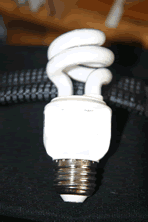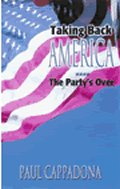EPA WARNS PUBLIC ABOUT MERCURY HAZARDS IN CFL LIGHT BULBS
By
Rosalind Peterson
January 29, 2011
NewsWithViews.com
First EPA News Brief Summary: "WASHINGTON – The U.S. Environmental Protection Agency (EPA) today updated its guidance on how to properly clean up a broken compact fluorescent lamp (CFL). [1] Included with the guidance is a new consumer brochure with CFL recycling and cleanup tips...CFLs contain a small amount of mercury sealed within the glass tubing. When a CFL breaks, some of the mercury is released as vapor and may pose potential health risks. The guidance and brochure will provide simple, user friendly directions to help prevent and reduce exposure to people from mercury pollution..." [2]
In
switching from incandescent light bulbs to fluorescent light bulbs and
CFLs our elected officials opened the door to a massive mercury pollution
problem across the United States threatening landfills and drinking
water supplies. Our elected officials have  been
derelict in making this information available to the public and providing
the necessary hazardous waste sites available for their recycling and
disposal in every local community [9]. And there should have been a
massive public education campaign to inform the public about these hazards.
It is too late for the fluorescent and CFL bulbs that have already been
tossed into dumpsters and landfills. We now can change this process
through education and laws regarding the hazardous material disposal
of these bulbs [10].
been
derelict in making this information available to the public and providing
the necessary hazardous waste sites available for their recycling and
disposal in every local community [9]. And there should have been a
massive public education campaign to inform the public about these hazards.
It is too late for the fluorescent and CFL bulbs that have already been
tossed into dumpsters and landfills. We now can change this process
through education and laws regarding the hazardous material disposal
of these bulbs [10].
According to the EPA the following list of light bulbs contain mercury: [7]
•
Other fluorescent bulbs, including linear, U-tube and circline fluorescent
tubes, bug zappers, tanning bulbs, black lights, germicidal bulbs, high
output bulbs, and cold-cathode fluorescent bulbs;
• High intensity discharge bulbs, which include
metal halide, ceramic metal halide, high pressure sodium, and mercury
vapor;
• Mercury short-arc bulbs; and
• Neon bulbs.
It should be noted that several studies have concluded the following with regard to cleanup by Vacuuming [14]. The State of Maine Study Report February 2008:
"...The study does not support recommending vacuuming as a cleanup option. Vacuuming is problematic because it tends to mix mercury concentrations in the room, promoting higher concentrations in the five foot breathing zone. In addition, the vacuum may become contaminated. Although using a wet wipe on some vacuum surfaces helped to lower residual mercury, expensive testing equipment was needed to evaluate cleanup effectiveness. Also some parts of the vacuum, such as the inside of the hose, are not as easy to wipe. The vacuum bag, when there is one, would need to be treated as universal waste if contaminated with mercury. It does appear that cheaper electric brooms or motorized sweepers are easier to decontaminate than more expensive vacuums with power heads and metal parts. It is not clear from this study what the exposure and hazards may be from handling a mercury-contaminated vacuum. Further study of vacuum decontamination procedures and exposure hazards would be useful..."
The EPA makes the following recommendations for cleanup and disposal of CFLs on their website: [8] Recycling and Disposal After a CFL Burns Out: "...EPA recommends that consumers take advantage of available local options for recycling CFLs, other fluorescent bulbs and all household hazardous wastes rather than disposing of them in regular household trash..."
• Recycling prevents the release of mercury into the environment. CFLs and other fluorescent bulbs often break when thrown into a dumpster, trash can or compactor, or when they end up in a landfill or incinerator. Learn more about CFLs and mercury.
• Other materials in the bulbs get reused. Recycling CFLs and other fluorescent bulbs allows the reuse of the glass, metals and other materials that make up fluorescent lights. Virtually all components of a fluorescent bulb can be recycled.
• Your area may require recycling. Some states and local jurisdictions have more stringent regulations than U.S. EPA does, and may require that you recycle CFLs and other mercury-containing light bulbs. California, Maine, New Hampshire, Minnesota, Vermont and Massachusetts, for example, all prohibit mercury-containing lamps from being discarded into landfills. Contact your local waste collection agency, which can tell you if such requirement exists in your state or locality.
• Starting in mid-2011, packaging for CFLs, LED bulbs and traditional incandescent bulbs will include new labels designed to help consumers select the most efficient bulbs that best fit their lighting needs. Both the packaging and the bulbs themselves will include disclosures if the bulbs contain mercury [11].
It is also important to note that the quality controls on many fluorescents and CFLs are limited due to the fact that many of these products are manufactured in other countries like China [29]. Thus, where U.S. companies like General Electric were held to strict manufacturing standards, foreign countries that manufacture and import these products to the U.S. are not held to these same manufacturing and consumer protection standards.
The Second EPA News Brief Summary: "WASHINGTON – The U.S. Environmental Protection Agency (EPA) today released guidance recommending that schools take steps to reduce potential exposures to PCBs from older fluorescent lighting fixtures. The guidance, part of EPA’s ongoing efforts to address potential PCB exposures in schools, is based on evidence that the older ballasts contain PCBs that can leak when the ballasts fail, leading to elevated levels of PCBs in the air of schools that should not represent an immediate threat but could pose health concerns if they persist over time..." [4]
"...Polychlorinated biphenyls, or PCBs, are man-made chemicals that persist in the environment and were widely used in construction materials and electrical products prior to 1978. PCBs can affect the immune system, reproductive system, nervous system and endocrine system and are potentially cancer causing if they build up in the body over long periods of time..." [5]
“...As we continue to learn more about the potential risks of PCBs in older buildings, EPA will work closely with schools and local officials to ensure the safety of students and teachers,” said EPA Assistant Administrator for Chemical Safety and Pollution Prevention Steve Owens. “This guidance on safely addressing the risks from PCB-containing light fixtures is part of EPA’s ongoing efforts to protect the health of our children and provide them with safe, healthy learning environments...”
"...Until the late 1970s, PCBs were commonly used as insulators in electrical equipment because they have a high tolerance for heat, do not easily burn, and are non-explosive. EPA banned the processing and distribution in commerce of PCBs in 1979 pursuant to the Toxic Substances Control Act due to their toxic effects. However, uses of older PCB-containing ballasts were allowed to continue, provided that the ballasts had not failed and the PCBs were not leaking..."
"...EPA believes many schools built in the U.S. before 1979 have light ballasts containing PCBs. A recent pilot study of three schools in New York City found that many light ballasts in the schools contained PCBs and had also failed, causing the PCBs to leak and contributing to increased levels in the air that school children breathe. EPA regional offices have also worked with school officials to address leaking PCBs in light ballasts in schools in Oregon, North Dakota, and Massachusetts..."
"...Given their widespread use before they were banned, if a school was built before 1979 or has not had a complete lighting retrofit since 1979, the fluorescent light ballasts probably contain PCBs.
Although intact, functioning ballasts do not pose a health threat, these lighting ballasts will all fail in time. For that reason, EPA recommends older PCB-containing lighting ballasts should be removed, whether as part of a previously scheduled lighting retrofit program or a stand-alone project. Schools that have older ballasts should examine them to see if they have failed or if PCB leaks are present. If a light ballast is leaking PCBs, federal law requires the immediate removal and disposal of the PCB-containing ballasts and disposal of any PCB-contaminated materials at an EPA approved facility..."
"...To prevent exposure if leaking ballasts are discovered, school personnel should wear protective clothing, including chemically resistant gloves, boots, and disposable overalls while surveying the ballasts. Replacement of leaking ballasts should be performed in a well-ventilated area, or supplemental ventilation or respiratory protection should be provided to reduce the potential for breathing in fumes..." [6]
"...EPA
has also developed information on how to properly handle and dispose
of PCB-containing fluorescent light ballasts and properly retrofit lighting
fixtures to remove potential PCB hazards.
In September 2009, EPA issued guidance to communities about potential
PCB contamination in the caulk of pre-1978 buildings. EPA also announced
additional research into the potential for PCBs in caulk to get into
the air. Research on that and other issues related to PCB exposures
is ongoing..."
| Subscribe to the NewsWithViews Daily News Alerts! |
"...School districts, building owners and others desiring technical guidance should contact EPA at 1-888-835-5372. Parents who are concerned their children may be attending a school with PCB-containing ballasts should ask their schools whether they have a plan to address PCBs in their schools..."
You can go the EPA website or links below and find more information about incandescent light bulbs [12], or other information on PCBs, fluorescent light bulbs, and CFLs. It is important that we all protect our children, our environment, and our drinking water from these toxic chemicals and their respective health effects [28].
Rosalind
Peterson
President Agriculture Defense Coalition
Post Office Box 499
Redwood Valley, California 95470
(707) 485-7520
E-Mail: info@californiaskywatch.com
1- More information on the clean up guidance.
2- More information on CFL light bulbs.
3-
EPA Website: View all news releases related to hazardous waste or View
all news releases related to pesticides and toxic chemicals
4- EPA Hazardous guidance document is available
online.
5- EPA:
More information on PCBs
6- EPA:
Information on handling and disposing of PCB-containing light ballasts.
7- EPA
Listing of Other Light Bulbs Containing Mercury: EPA Cleanup
Brochure.
8- EPA.
EPA Cleanup
Instructions for Broken CFLs.
9- EPA
Cleanup and Safe Disposal of Compact Fluorescent Light Bulbs.
10- EPA
Public Information.
• CFLs and Mercury
• Cleaning Up a Broken CFL
• Recycling and Disposal After a CFL Burns Out
11- Federal Trade Commission's June 2010 Appliance
Labeling Rule: Starting in mid-2011, packaging for CFLs, LED bulbs and
traditional incandescent bulbs will include new labels designed to help
consumers select the most efficient bulbs that best fit their lighting
needs. Both the packaging and the bulbs themselves will include disclosures
if the bulbs contain mercury.
12- EPA Website Q&A About Incandescent Light Bulbs:
13- February 2008 Report: Shedding Light on Mercury Risks from CFL Breakage
14-
February 2008 Report: Maine
Compact Fluorescent Lamp Breakage Study Report Executive Summary.
Full
Report:
15- EPA Website-Mercury
Spills
16- European Commission Adopt this Report on Health
and Other Effects from Mercury in Fluorescent and CFLs on May 18, 2010
- SCHER Report: Information
on Fluorescent Light Bulbs
17- EPA FACT Sheet 2007 – Mercury Hazards Light
18- General Electric 2007 Health Hazards MSDS Bulbs
19- Hazards of Fluorescent Light Bulbs April 2007 - Mercury EPA
20- EPA Mercury
21- How to handle Broken Fluorescent Bulbs
22- EPA How to Handle Hazardous Wastes like Mercury 2007
23- More Information on Fluorescent & CFL Light Bulbs
24- U.S. Environment Protection Agency
25- History of the Environmental Protection Agency
26-
Historical
Time Line EPA
27- EPA
Mercury Pollution
28- The National Wildlife Federation Magazine August/September 2005 Issue “Mercury’s Mounting Toll on Birds” “Mercury Rising” by Paul Tolme
This article is about mercury entering the food chain and Biologist Dave Evers documented “…widespread mercury contamination in songbirds… it also raised concerns about the deadly neurotoxin’s ability to enter food webs and hard wildlife in previously unknown ways…”
According to Tolme: “…The study was part of a special report on mercury published in the April 2005 issue of Ecotoxicology, which included 21 papers from 71 scientists. In addition, to the songbird findings, the report documented that large, fish-eating species like the common loon contain more mercury than any other birds…”
Health Effects noted by Tolme: “…Mercury has long bee deemed a pubic health threat. Ingested when people eat fish from contaminated waters, it is lethal at high doses. At lower doses mercury is especially dangerous to children, because it harms the development and function of the central nervous system…”
Route to humans noted in article: “…In nature, it is also well known that mercury often ends up in fish and their predators, such as loons and eagles. Washed into rivers, lakes and streams, inorganic mercury transforms into its toxic form. Methylmercury, then moves up the aquatic food chain, from microbes and aquatic insects to small fish to larger fish to water birds and fish-eating mammals…Every step of the way, the poison concentrates, a process call biomagnification…”
The article notes many mercury hot spots in the United States. When we convert from incandescent light bulbs to fluorescent light bulbs this will add to our mercury contamination problems impact more wildlife and people as it leaches into rivers and stream from waste dumps and toxic waste sites.
29- May 2007 Smithsonian Magazine “Let There Be Light”, by Richard Conniff. “Incandescent or Fluorescent? What would Thomas Edison do?”
“…The CFL’s admirers say it is not only far more efficient and cooler, both literally and figuratively, but also lasts about ten times longer (although it doesn’t last as long if you turn it on and off too often)…Hence the strange spectacle of environmentalists advising people that they can help save the world by taking perfectly good, working light bulbs and throwing them in the trash…”
“…But the most powerful force pushing the incandescent bulb over the cliff is undoubtedly Wal-Mart, the largest retailer on earth…” Wal-Mart sees huge profits and monopoly sales when incandescent light bulbs are banned. Wal-Mart may be working to corner the market on Fluorescents by importing them from foreign countries like China where few if any regulations are in place to protect consumers from the mercury contained in these bulbs and what type will be produced. It will be cheaper to produce the ones without the automatic shut off built in to protect consumers if the bulbs break while in usage.
It
will be a costly switch for most American in that the cost for Fluorescents
are very high, not only at the checkout stand but in environment, due
to their varying mercury content. Lights are benefiting people around
the world. Conniff “…Even today in developing regions, the
arrival of the light bulb often leads to a decline in the birthrate
and the expansion of literacy...”
The varying technologies for producing Fluorescent light bulbs is also
another problematic factor. The quality of light may vary and also vary
from the better “warm white” to whether or not it carries
the federal Energy Star Label, “…which insures efficiency,
durability and consistency…” Conniff writes: “…there
are three different technologies for producing light after you flip
the switch, one instant and the others not so instant…the product
labeling on CFLs still often omits the kind of information consumers
need, such as the Kelvin range…”
“…Steve Denbars, a professor of material science at the University of California at Santa Barbara…You don’t want to use CFLs for down lighting over kitchen counters. A champagne cork hits one, you’ve just dusted your whole kitchen with mercury…the mercury issue is also why we need to look at new technologies that can beat CFLs, and do it in a safer manner…”
“Den Bars expects light-emitting diodes, or LEDs, to be cheap enough for widespread household use within four years. LEDs are already common in mobile phones and some flashlights… where incandescent bulbs convert less than 10 percent of incoming energy into light, and CFLs manage 18 to 20 percent, LEDs boast a 40 percent conversion rate, without mercury or other contaminants…”
There are too many drawbacks to converting from incandescent to fluorescent light bulbs at this point. It would be better to wait and allow technology to produce the best of all possible products for consumers to use…ones with less negative environmental impacts like the mercury laden fluorescent light bulbs.
30- Ukiah Daily Journal June 1, 2007 Article: “Mercury Pollution Prevention” by Dave Richardson. The Russian River Watershed Association
31- New York Times – July 8, 2008 Fluorescent Light Bulbs – Mercury Problems - Unless you have unbreakable fluorescent light bulbs the problem remains and disposal is still a problem. Selenium may not be the answer.
32- Lenntech Health & Environmental Problems with Selenium July 2008
33- August 31, 2009 – Health Problems for English When Incandescent Light Bulbs are phased out. Telegraph U.K. News
34- Website Investigates Health Effects September 1, 2009
35- Canadian Health Effect Study 2006
36- Resolutions (2) Health Effects of Electromagnetic Radiation
37- Health Effects of Electricity and EMF 2006
� 2011 - Rosalind Peterson - All Rights Reserved









 Share
This Article
Share
This Article



